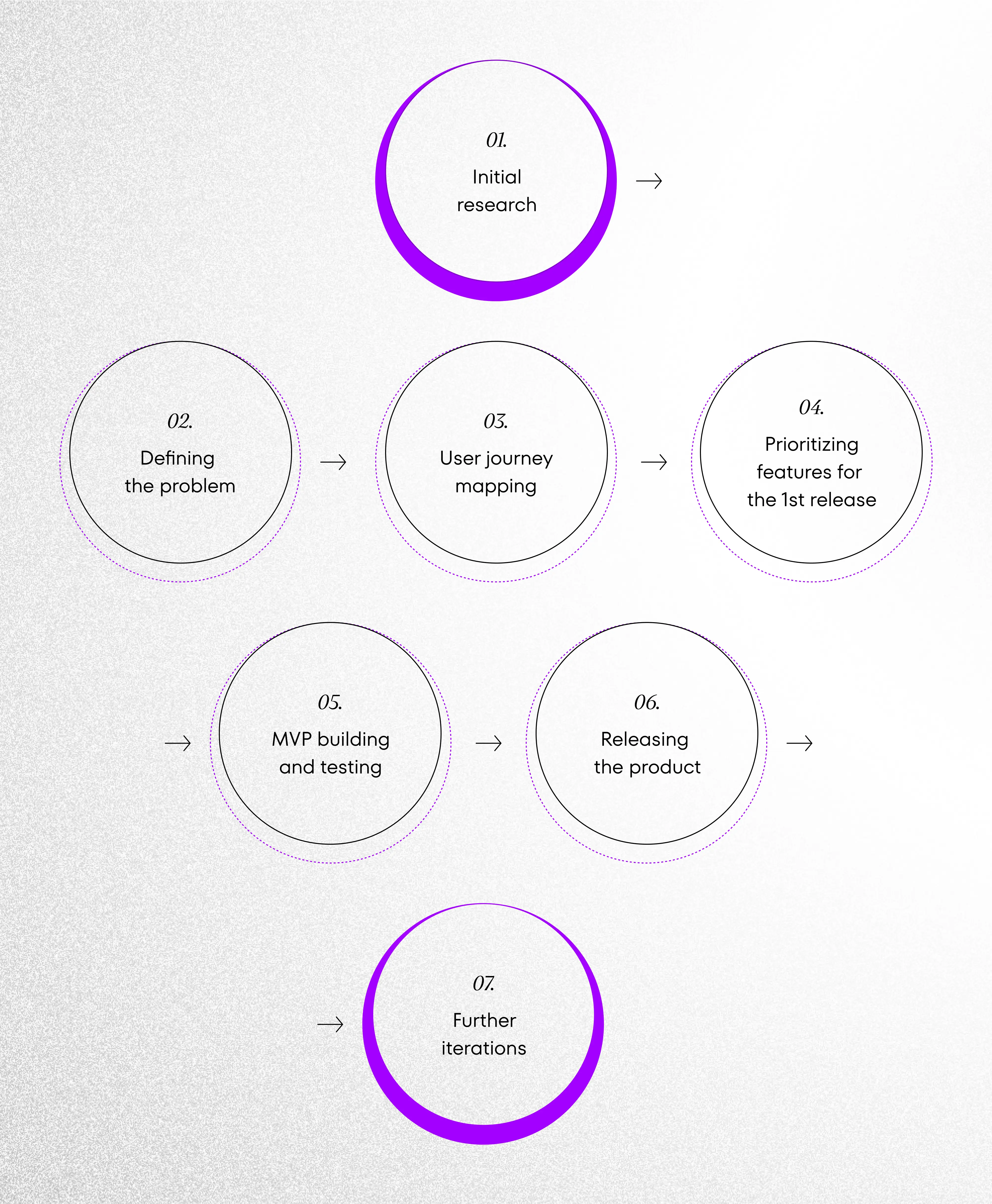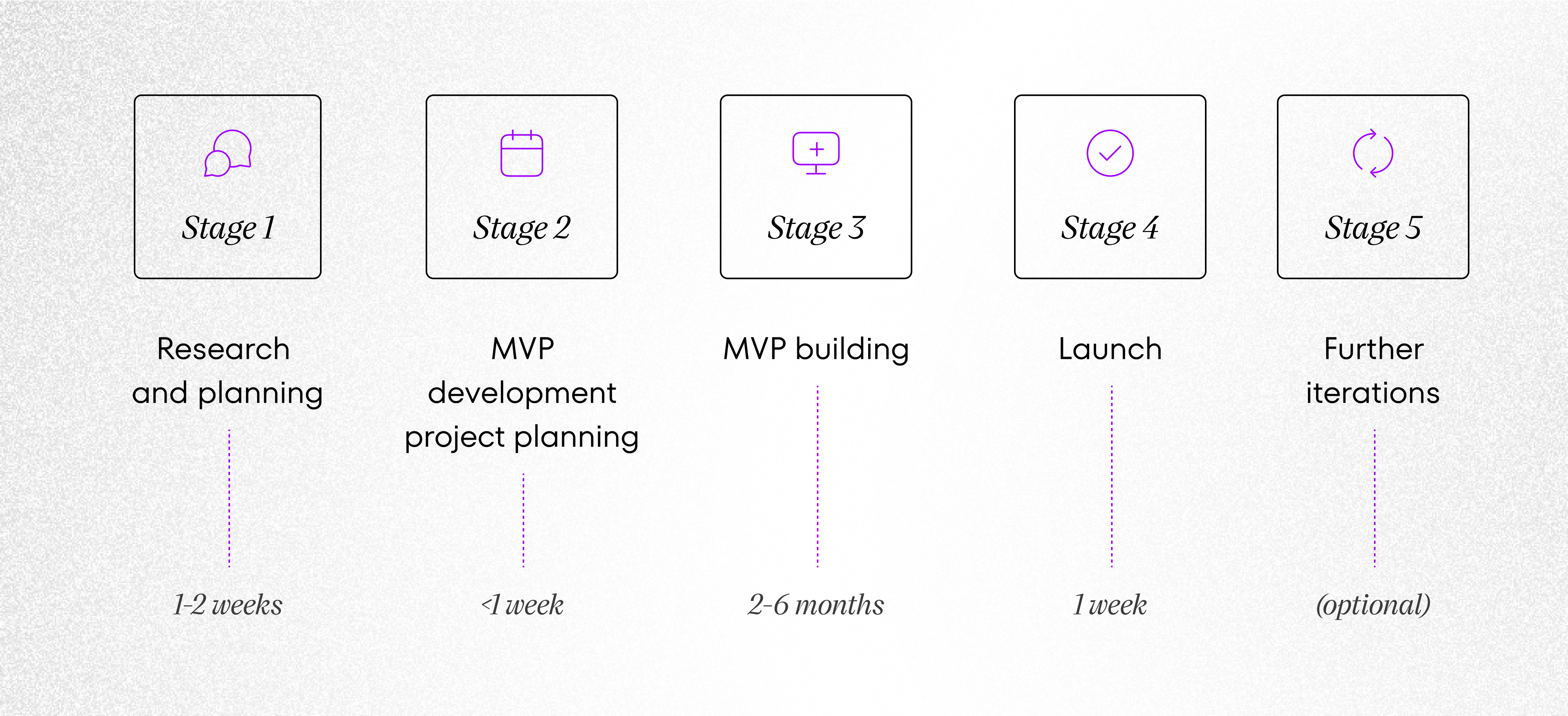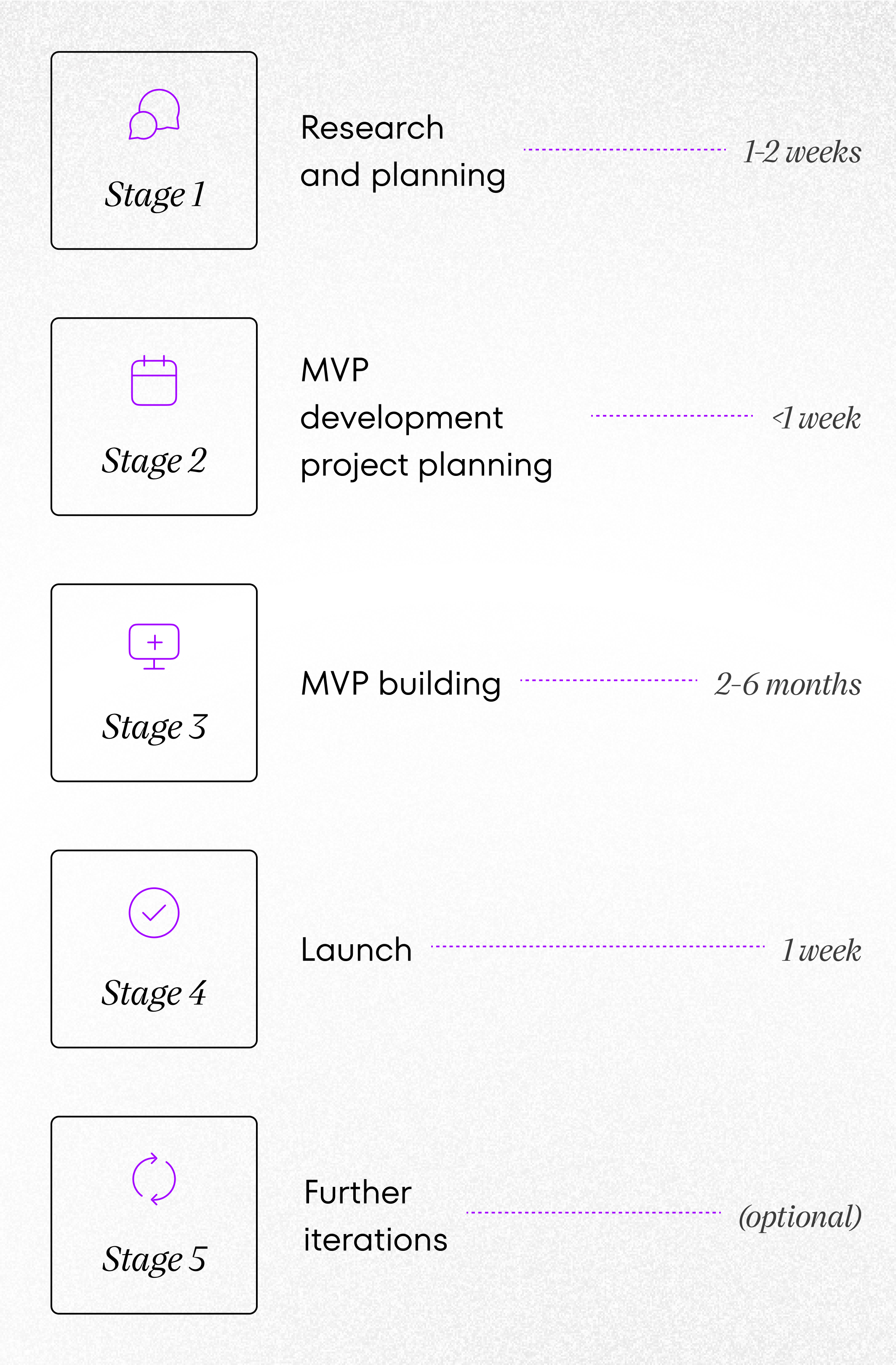March 18th, 2021 | by Klaudia Raczek
MVP Software Development – How to Succeed at Creating Digital Products?

Table of contents
Congrats! You’ve come up with a game-changing idea for a new digital tool. All you need now is to get it on the market and start counting profits, right?
Well, the truth is it’s not so simple. According to “How Many Startups Fail and Why?” by Sean Bryant, around 90% of startups fail. It only confirms that starting a business based on custom software development projects is not as easy as most people think.
Many digital tools fail because their initiators don’t begin with a Minimum Viable Product (MVP), while the MVP is actually the best way to start.
How will you validate if there is true market demand for your tool or service? Which technologies should you pick? How to ensure your product won’t fail in one year? How to outsmart your competitors?
If you haven’t asked yourself these questions yet, now it’s time to do so. MVP development is a common practice that will help you find the right answers.
If you are not embarrassed by the first version of your product, you’ve launched too late.
Reid Hoffmann
In this article, we explain everything you need to know before you start building your MVP that may be essential in taking you to the lucky 10% of thriving startups. In particular, we explain:
- What is a Minimum Viable Product (MVP)?
- How to transform your idea into an MVP?
- Why is Agile the best approach in MVP development?
- How to pick the right technology stack?
- The cost of creating an MVP
- The time required for MVP development
- The role of MVP in the software development process
What is a Minimum Viable Product (MVP)?
A Minimum Viable Product, or MVP, is an early release of the product with just enough features that allow you to test the validity of your vision and gather users’ feedback for further development.
The focus here must be on the “minimum” – instead of developing a full-fledged product, you decide on the key features and get the tool out to potential users to see if it satisfies their needs or not.
The concept of a Minimum Viable Product was coined by Eric Ries in his book titled “The Lean Startup” which tackles a methodology of product development. His definition is as follows:
Minimum Viable Product is that version of a new product that allows a team to collect the maximum amount of validated learning about customers with the least effort.
The MVP approach is a tried-and-tested methodology that works to create products people genuinely like. Let’s see how exactly the MVP helps in creating useful digital products!
How to transform your concept into an MVP?
MVP building consists of several stages:
Initial research
This step is incredibly important for successful MVP development.
If your new product doesn’t solve real problems experienced by users, you simply won’t build a user base. According to CB Insights titled “The Top 20 Reasons Startups Fail” 42% of startups fail because there is no market need for the products they propose. This means you have to validate your concept and understand what your potential customers want before you can provide the right solution.
Don’t forget to check your competition: it’s more than likely that other companies already offer solutions to the same problem you are trying to solve. That doesn’t mean that you should abandon the project altogether, but rather check what your competitors’ offering is missing – perhaps you will be able to capitalize on that gap.
Definition of the problem
You must be able to clearly and simply define that problem, no matter how technical it is. There are a number of questions that can help you arrive at the right answer:
- What problem am I solving?
- Why am I solving this problem?
- Who will benefit from my solution?
- How will my customers benefit from this project?
This will be essential in showing customers how your innovative tool solves their existing problems.
An important thing to remember here is that the MVP must be built with customers’ needs in mind, and the minimum features must also match customer requirements identified in the initial ideation stages. – Hanieh Chaichi
User journey mapping
Once you’ve defined the problem, you should be able to establish the primary goal of your new tool.
Think about the steps that will bring users to this goal, bearing in mind that this user journey should be as simple as possible. There’s no need to think about the features just yet – focus on the primary functionality.
Once you have mapped the user journey, you can move on to wireframing and design. The easier and more aesthetically pleasing the design, the more users will try and continue to use your product. So find the right partner who will take care of these tasks for you if you don’t have an in-house design team.
Prioritizing features for the first release
If almost 50% of software product features are rarely or never used, as you can read in David Rice’s article on LinkedIn, why waste time and effort on building them as you prepare for the first release?
What features should be postponed to subsequent iterations of the product? Make a list of minimum components that should be implemented first – you’ll quickly understand there’s no need to include all the features immediately. Plan a scale-up of your product where features of lesser importance could be added in the future.
MVP building and testing
Once you’ve designed the tool and identified the core features, building the MVP is your next step.
It’s important to choose the right tech stack for development works (more on this later) and test the progress of work. Your MVP is the model example you’ll present to users, so make sure it’s usable and fully functional. Otherwise, the user opinions will focus on the bugs and errors. Also, before you get the app in front of a potential user, make sure you test the final version for bugs and performance.
Release
Indeed! The launch is also part of MVP development.
You must think about the plan of action, or pick a partner who will help you release the product and gather customer feedback for analysis. That data is your best guide on this journey and taking the right next step: making an informed decision on how to move forward.
Further iterations
What you learn from users provides you with ideas for future product evolution, confirming some of your assumptions about the tool, or discarding others.
You may decide to move on with adjustments and scale-up, change your direction or abandon the idea altogether. At this point, it will become clear what’s the best way to move forward.
From concept to an MVP


Why is Agile the best approach from the owner’s perspective?
The Agile methodology leverages the power of MVP and it’s the main reason why this methodology is more advantageous than others.
You build a software product with just enough features to validate your idea with actual users, then gather feedback that allows you to quickly refine your product. It’s the best data you can get to move on with building a usable product that truly adds value.
Different product development methodologies may put greater emphasis on building the “perfect” final product, which might be time- and resource-consuming – but that’s not the hardest part. Imagine you put all this hard work only to discover that your users won’t benefit from some of the functionalities anyway…
The Minimum Viable Product plays an important part in Agile project management by ensuring the iterations are done smartly. This methodology is effective because it’s user-centric and focuses on understanding the needs of the customers – it simply leaves no room for guessing what they like. Incorporating an MVP in the journey guides you through each iteration, ensuring you build a better final product.
What technology stack should you pick?
There’s no simple answer to this question because the tech stack required for MVP development depends on the functionality to be included in the software development project. It should also take into account the time you have at hand and the budget.
If you don’t have a devs team to help you with that choice, contact an outsourcing development partner who specializes in MVP delivery. They’ll be able to carry out the analysis and assessment of needs and identify the best technologies to develop specific features.
If you’re considering launching an MVP, we’re happy to consult and share our domain knowledge at every stage of the MVP development process. From your side, it’s key to understand the priorities: if you want to create an app that offers an impeccable user experience, you’ll have to invest in reliable front-end technologies.
How much does it cost to create an MVP?
It will depend on the nature of your product and the resources you have at hand.
To build an MVP, you’ll need a team that includes a project manager, a UX/UI designer, and a software developer. Check the 2020 HackerRank Developer Skills Report report, it can give you an idea about the developers’ rates.
In our experience, creating an MVP can cost anything from $40-120k, depending on the scope. We shed some light on the MVP price in the linked article. Moreover, we once worked on an MVP project that amounted to $20k.
If you don’t have the people on your team, you can opt to delegate full supervision of MVP development to an external partner – in that scenario, they’ll take care of the entire project for you, including its price valuation. You can also partially or fully outsource their technical services, which will give you quick access to specific tech skills, but coordination, delivery concerns, and risk management will be partially or totally on your side.
If you’re looking for detailed instructions for your MVP development, refer to our earlier article “15 Steps to Build an Effective MVP“, where we describe the process step-by-step. You can also use the free checklist to assess your readiness for building an MVP.
PLAN YOUR MVP STEP-BY-STEP WITH OUR CHECKLIST
Download checklistHow long does it take to create an MVP?
The time dedicated to MVP development will depend on the scope of your solution. It should take long enough to fully implement the set of functionalities that are enough to test the business assumption.
It doesn’t mean that this should be a low-quality product, but quite the contrary: MVP building should be treated as your full release, so ensure it’s stable and performs as expected. What will typically be involved in a full-scale MVP development?
Stage 1: Research and planning (1-2 weeks)
- business analysis
- feature road mapping
- choosing a technology stack
Stage 2: MVP development project planning (<1 week)
- defining value and scope
- deliverables
- timelines
Stage 3: MVP building (2-6 months)
- UX design
- UI design
- coding
- testing
Stage 4: Launch (1 week)
- collecting user reviews
Stage 5: Further iterations (optional)
As you can see, MVP development is a complex process, where every step is equally important. The hours required for each stage depend on the scope and complexity of the tool. Considering the workload, you may want to outsource your project to an experienced custom software development partner who will be able to provide valuable assistance throughout MVP development.
Milestones of MVP Process


The role of MVP in software development
The Minimum Viable Product is your first step towards building a better and more useful tool. It’s your best choice when it comes to validating the value proposition of software development projects, shortening the time-to-market, and reducing product development costs. More specifically, MVP development allows for:
Testing a product idea with minimum resources
In MVP, “minimum” is the keyword. It’s much cheaper to build a basic version of a product with the minimum set of features than a full-fledged product. You’re focusing on a minimum set of features to satisfy user needs before moving on to adding new ones. Testing a full-scale software project would cost you a lot more and could prove your solution doesn’t satisfy early adopters.
Collecting user feedback quickly
The purpose of initially focusing on just the minimum set of features is to present the basic product to potential users to see if it fulfills their needs. It’s very rare for any business to nail the needs of their market niche right from the start. MVP development allows you to include the basic functionality, test concrete assumptions early on with bonafide users, and gather ideas for future scaleup.
Maximizing cost-effectiveness of the development process
It goes without saying that building an initial version of the product is a lot cheaper than getting a full-fledged version straight to the market. A finished product that isn’t well adjusted to user needs will certainly require costly changes. If done right, the focus on building an MVP can help you minimize development hours, saving you time and money.
[box_cta cform=”7379″ html_id=”file_download__mvp_development_checklist” cta=”Download checklist” link=”6840″ html_id=”file_download__mvp_development_checklist”]PLAN YOUR MVP STEP-BY-STEP WITH OUR CHECKLIST[/box_cta]
The MVP approach – summary
If you want to build a great product, launch it before you think it’s ready!
I know it’s counterintuitive – that’s why the MVP framework was created to help you do that in an organized way. Focus on releasing the product with minimum intended functionality and learn how to further improve it from early adopters instead of releasing an overcomplicated and/or irrelevant app.
MVP allows you to obtain early validation directly from your future customers, helping you understand if you’re going the right way or cut losses if the project proves to be a miss.
Given the complexity of MVP creation, it’s good to pair with a trusted outsourcing partner who will be able to carry out business analysis, narrow down the scope of your tool, design, tech stack, coding, release, and further scale-up of your tool.
If you’d like to know how we can help you with MVP development, check the linked guide.


